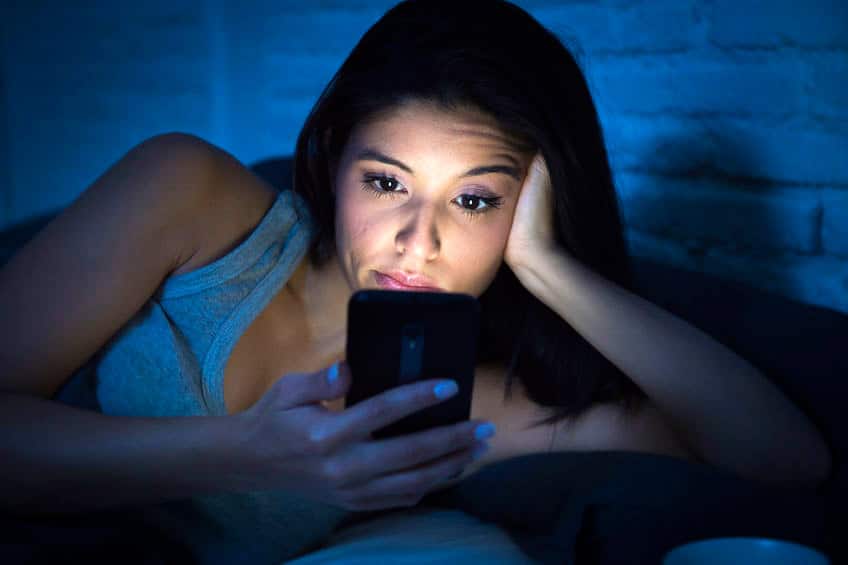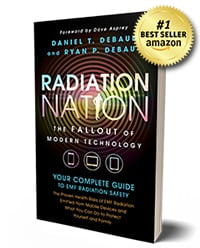Your cart is currently empty!

Falling Asleep on the Phone? The Effects of Mobile EMF Radiation on Sleep
Last Updated on December 30, 2024

The need for sleep, as we all know, is extremely important. And today, the talk isn’t about just getting enough hours, but also getting “quality” sleep.
“Quality” sleep, as studies suggest, is deep sleep that allows us to experience enough Rapid Eye Movement (REM) sleep. REM sleep doesn’t occur right away when you fall asleep; it can take time – up to ninety minutes – before we reach the REM state.
New research shows that something called “REM deprivation” is possible, which means people that feel like they sleep enough hours really aren’t resting as much as they should, which can be detrimental to their health and well-being.
When we don’t rest as well as we should, our body misses out on the opportunity to detox and recharge its organs. Needless to say, missing out on “quality” sleep impacts every aspect of our lives.
So, as the focus shifts to the quality of sleep rather than length, we need to start asking ourselves the question, “How do I really sleep better?”
More than ever, people are complaining about feeling lethargic, having low energy levels, and feeling depleted throughout their bodies.
According to a 2015 poll conducted by YouGov, only one in seven Americans report feeling rested after they wake up. Today, it is predicted that this number is even higher.
Why aren’t we feeling more rested? It might have something to do with EMFs.
The Impact of EMFs of Sleep
Electromagnetic Fields, also know as EMFs, are created by electrical equipment and electronic devices, such as laptops and cell phones. More and more evidence is showing that this low level radiation is having negative effects on humans. And some of those negative effects are directly impacting our sleep.
Below are some of the most common producers of EMFs in the home:
- Cell phones
- WiFi
- Alarm clocks
- Tablets
- Computers
- Baby monitors
- Televisions
- Home wiring
- Microwaves
- Wireless game controllers
- Security systems
Before we move on, it’s important to note that there are two types of EMFs we are concerned with, Extremely Low Frequency (ELF) and higher frequency Radio Frequency (RF) radiation.
ELF EMFs are created by all electronic devices. RF EMFs are generated by all electronic devices that have antennas and wireless capabilities, such as cell phones and tablets.
Both of these types of EMFs are man-made and both can have a negative impact on humans – higher frequency, RF EMFs may impact us faster.
How fast?
A 2008 study conducted by researchers in Sweden and Wayne State University demonstrated that individuals who use their cell phone for more than three hours before going to bed experience disrupted sleep patterns, in addition to headaches and difficulties concentrating.
And while some people attribute the inability to sleep simply to the “blue light” emitted by devices, further research is pointing to EMF exposure as a contributing factor. While blue light does in fact affect how our bodies experience sleep, simply calling it “blue light” minimizes the problem and doesn’t address the deeper issue of exposure to this type of radiation.
In fact, a 2010 study showed that individuals exposed to EMFs had serious changes to their pineal gland, specifically a disruption in the production of melatonin. This study explained that while the pineal gland can experience EMFs as light, the result is a fairly significant decrease in melatonin.
Why does a lack of melatonin impact sleep?
Melatonin is one of the primary hormones responsible for regulating our sleep-wake cycles. Small amounts of melatonin are found in food, but it can very rarely be replaced at high enough levels if your body is not producing it correctly. Some studies are beginning to reveal that a disruption in melatonin production not only impacts sleep, but that it may also lead to possible long-term health issues, such as cancer, heart disease, and depression.
And that’s not all.
Another study demonstrated that individuals who are exposed to EMF radiation every day for one hour over thirty days had a harder time getting into REM sleep. This could explain why so many Americans wake up feeling unrested.
How to Achieve Better Sleep
One of the best and easiest ways of achieving better sleep is removing WiFi along with all wireless or EMF-emitting devices from your bedroom. The more you can limit your exposure to EMFs, the better. If you have to keep your cell phone near you or use it as an alarm clock, keep it at least 4-5 feet away form your bed. This goes for tablets and computers as well.
You can also consider how your furniture is arranged in your home. We don’t often give much thought to what’s inside our walls, but some walls contain more wiring than others. By moving your furniture away from walls and wiring, you can help minimize your exposure to EMF radiation. If the idea of rearranging your whole home or moving all of your furniture away from walls seems ludicrous, at least consider the placement of the beds in your home.
While modern life makes it difficult to remove EMFs entirely, even something as simple as taking a day off can help dramatically.
Rather than using devices that emit EMFs as entertainment, think about doing something else, like getting outside. Getting outside regularly, especially barefoot (also known as “earthing“) is a great way to minimize some of the negative effects from EMF exposure.
Looking for other options?
Try reading a book (not on a device!) or enjoying quality time with family and friends. Both of these activities will not only lower your exposure to EMFs, but they help reduce stress, too!
At the end of the day, your end of the day will be much better if you can limit your exposure to EMFs. And your mornings will thank you, too!



























